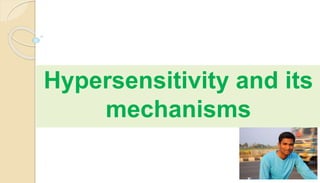
Hypersensitivity reaction (HR) and mechanisms
- 2. The term was barrowed from human medicine terminology (organism or group of organisms, which are sensitive to a pathogen agent) Synonyms – suprasensitivity, hypersuceptability, hyperergy
- 3. Coming to plant pathology ……………. Ward (The Cambridge Botanist) 1st to recognise significance of hypersensitivity as a defence mechanism of plant against plant pathogens (parasites) He observed no difference between the behaviour of the resistant and susceptible host plant until direct, physiological contact is established.
- 4. Ward recognised both extremes ‘highest resistance’ and ‘highest tolerance’ are connected and mode of reaction is influenced by environmental factors. But ….. why a pathogen such as Puccinia dispersa discontinues its growth prematurely in the hypertensive host …
- 5. After 10 yrs ward gained breakthrough form Stakman… that he discovered Eriksons phenomenon f.sp. of rust fungus contains many physiological races
- 6. Hypersensitive response (HR) Stakman, 1915 HR is a cell defence mechanism or type or programmed cell death, that can be used by host plants which prevents the spread of disease caused by pathogen Characterised by rapid death (autolysis) of cells around the infection area • The term hypersensitivity was introduced in plant pathology by E .C. Stakman, 1915 • Due to variability among plant pathogen, stakman called the pathogen as “Shifty enemies”
- 8. Due to autolysis it prevents the rapid spread of disease to other parts of the plants Mostly hypersensitive response associated with the death of a small number of cells at and around the site of infection
- 9. After infection …………… The tissue turned to brown and die destructing activity of infecting cells and kills too rapidly, in the same time it also ceases pathogen growth. Thereby, infection limited to localised necrotic tissue and plant escapes the diseases (Ward. 1902)
- 11. The HR is the culmination of the plant defence responses initiated by the recognition of specific pathogen signal molecules, known as elicitors by plant.
- 12. The HR occur only in specific host-pathogen combination in which the host and pathogen are incompatible. Its occur only in Vertical resistance.
- 13. Mechanism • Defense mechanism, involves interaction between products of an ‘avr’gene of the pathogen and a matching ‘R’ gene of the plant (Dodds et al., 2006). This compatible reaction between ‘R’ gene and elicitor activates the biochemical reaction and defence related compounds
- 15. In phase one of the HR, the activation of R genes triggers an ion flux, involving an efflux of hydroxide and potassium outside the cells, and an influx of calcium and hydrogen ions into the cell. In phase two, the cells involved in the HR generate an oxidative burst by producing reactive oxygen species (ROS), superoxide anions, hydrogen peroxide, hydroxyl radicals and nitrous oxide. These compounds affect cellular membrane function, in part by inducing lipid peroxidation and by causing lipid damage
- 16. This actions will increases the production of Salysilic acid (SAR), jasmonic acid and ethylene (ISR) SAR triggered by bio-trophic pathogen ISR triggered by necrotrophic pathogen
- 18. Some biochemical reactions and physiological aspects of hypersensitivity Respiration rate, oxidise levels, peroxidase level and mitochondrial number (Kiraly, 1980) Phenolic and flavonoid compounds are increased (Loebenstein, 1972)
- 20. Depolarization of the membrane Electrolyte leakage Loss of selective membrane permeability Apposition of material to the cell wall Increased cytoplasmic streaming Translocation of the nucleus to infection site Callose deposition and papillae formation Condensation of Nucleoplasm and cytoplasm Disintegration of Cytoskeleton Cleavage of nuclear DNA
- 21. In 1946, E. Gaümann proposed that in many host–pathogen combinations plants remain resistant through hypersensitivity; i.e., the attacked cells are so sensitive to the pathogen that they and some adjacent cells die immediately and in that way they isolate or cause the death of the pathogen.
- 22. In the early 1960s, it was proposed that, in some cases, disease resistance is brought about by phytoalexins, i.e., antimicrobial plant substances that either are absent or are present at non detectable levels in healthy plants, but accumulate to high levels in response to attack by a pathogen
- 23. References George N Agrios, 2005. Plant Pathology 5th Edition pp221- 237 Horsfall, J.G. ed., 2012. Plant Pathology V1: The Diseased Plant. Elsevier. Kiraly, Z. 1980. Defenses triggered by the invader: hypersensitivity, pp. 201-225. In J. Horsfall & E. B. Cowling [eds.], Plant diseases, vol. V. Academic, New York. Loebenstein, G. 1972. Localization and induced resistance in virus-infected plants. Annu. Rev. Phytopathol. 10: 177- 206. Balint‐Kurti, P., 2019. The plant hypersensitive response: concepts, control and consequences. Molecular plant pathology, 20(8), pp.1163-1178.
